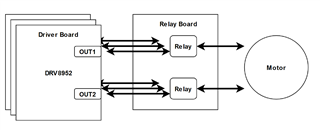Tool/software:
Hello Team,
We have a system that uses the motor driver DRV8952DDWR.
OUT1 & OUT2 forms and H Bridge and OUT3 & OUT4 forms the second H Bridge.
We are using 2*24V DC motor.
The DC Motor will be in a test jig
We have a relay board between the driver board and the DC Motor
The relay board help to connect/test different driver boards with the same motor.

The relays will be closed all the time and thus we get a the expected behavior.
Can you please clarify the following doubts we re having.
1). If a driver board is controlling the motor and the motor is rotating in a direction and if we switch the motor to some other driver board with the relay without giving any time to freewheel, will this damage the 2nd driver IC?.
2). If this damages the IC, can we use a bidirectional TVS diode across the motor to dampen the back EMF?.
3). All driver boards are independently powered and have their own MCU and software. Which means the driver will be configured to rotate in forward or reverse direction while switching with the relay. Will this create any problem?.
Looking for your reply


